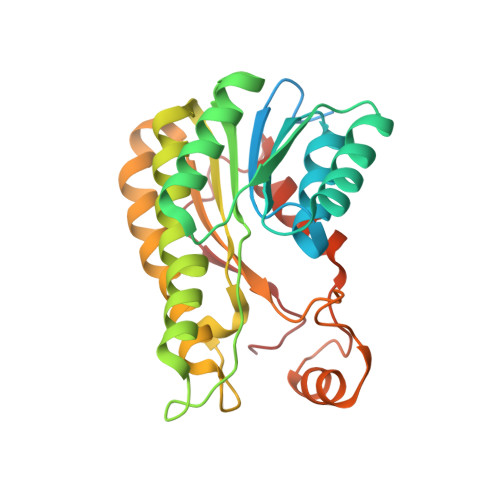Structure-guided design of Serratia marcescens short-chain dehydrogenase/reductase for stereoselective synthesis of (R)-phenylephrine.
Liu, J.-S., Kuan, Y.-C., Tsou, Y., Lin, T.-Y., Hsu, W.-H., Yang, M.-T., Lin, J.-Y., Wang, W.-C.(2018) Sci Rep 8: 2316-2316
- PubMed: 29396495
- DOI: https://doi.org/10.1038/s41598-018-19235-y
- Primary Citation of Related Structures:
5WUL, 5WUW, 5WVA - PubMed Abstract:
Bioconversion is useful to produce optically pure enantiomers in the pharmaceutical industry, thereby avoiding problems with side reactions during organic synthesis processes. A short-chain dehydrogenase/reductase from Serratia marcescens BCRC 10948 (SmSDR) can stereoselectively convert 1-(3-hydroxyphenyl)-2-(methylamino) ethanone (HPMAE) into (R)-phenylephrine [(R)-PE], which is marketed medically as a nasal decongestant agent. The whole-cell conversion process for the synthesis of (R)-PE using SmSDR was reported to have an unexpectedly low conversion rate. We reported the crystal structure of the SmSDR and designed profitable variants to improve the enzymatic activity by structure-guided approach. Several important residues in the structure were observed to form hydrophobic clusters that stabilize the mobile loops surrounding the pocket. Of these, Phe98 and Phe202 face toward each other and connect the upper curvature from the two arms (i.e., the α7 helix and loopβ4-α4). The mutant structure of the double substitutions (F98YF202Y) exhibited a hydrogen bond between the curvatures that stabilizes the flexible arms. Site-directed mutagenesis characterization revealed that the mutations (F98Y, F98YF202Y, and F98YF202L) of the flexible loops that stabilize the region exhibited a higher transformation activity toward HPMAE. Together, our results suggest a robust structure-guided approach that can be used to generate a valuable engineered variant for pharmaceutical applications.
Organizational Affiliation:
Institute of Molecular and Cellular Biology & Department of Life Science, National Tsing Hua University, Hsinchu, 300, Taiwan.














